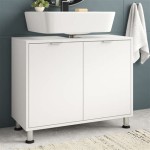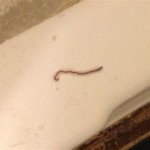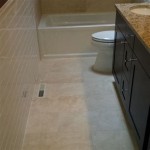Can I Use Liquid Plumr In My Bathroom Sink Drain?
Bathroom sinks are prone to clogs. Hair, soap scum, toothpaste remnants, and other debris accumulate over time, restricting water flow and potentially leading to complete blockage. When faced with a slow or clogged bathroom sink drain, many individuals turn to readily available chemical drain cleaners like Liquid Plumr. Understanding the composition, functionality, and potential effects of Liquid Plumr is crucial before using it in a bathroom sink.
Liquid Plumr is a brand name that encompasses a range of drain cleaning products. These products typically contain a combination of chemicals designed to dissolve or break down the organic matter causing the clog. The specific chemical composition can vary between different Liquid Plumr formulations, but common active ingredients include sodium hypochlorite (bleach) and sodium hydroxide (lye, also known as caustic soda). Other ingredients may include surfactants, which help to loosen and dislodge the clog, and thickeners, which allow the product to cling to the pipe walls for extended contact time.
The mechanism by which Liquid Plumr works involves a chemical reaction. Sodium hydroxide is a highly alkaline substance that reacts with fats, oils, greases, and proteins – all common components of bathroom sink clogs. This reaction, known as saponification, converts these substances into a more soluble form, essentially turning them into soap. The heat generated by the reaction can also help to melt and break down the clog. Sodium hypochlorite acts as an oxidizer, further breaking down organic materials and also providing a bleaching effect. The combination of these chemical actions aims to dissolve or dislodge the blockage, allowing water to flow freely through the drain.
While Liquid Plumr is designed to clear clogged drains, its use should be approached with caution. The chemicals involved are corrosive and can pose risks to both the user and the plumbing system. Understanding these risks and taking appropriate precautions is essential for safe and effective use.
Understanding the Potential Risks
One of the primary concerns associated with Liquid Plumr is its corrosive nature. Sodium hydroxide, in particular, is highly caustic and can cause severe burns upon contact with skin, eyes, or mucous membranes. Inhalation of its fumes can irritate the respiratory tract. Therefore, it is critical to wear appropriate personal protective equipment (PPE) when handling Liquid Plumr. This includes gloves, eye protection (such as goggles), and potentially a mask to avoid inhaling fumes. Proper ventilation is also important; ensure the bathroom is well-ventilated by opening windows or turning on an exhaust fan. Avoid splashing the product and wash hands thoroughly after use, even if gloves were worn.
Another risk relates to the potential for damage to the plumbing system itself. While many modern plumbing systems are constructed from PVC or ABS plastic, older systems may incorporate metal pipes, particularly in connections or traps. Liquid Plumr can corrode certain metals, such as aluminum or galvanized steel, leading to leaks or even complete pipe failure. Prolonged or repeated use of Liquid Plumr can weaken even plastic pipes over time, making them more susceptible to cracks or breaks. The heat generated by the chemical reaction can also contribute to pipe damage, especially in older or weakened plumbing.
Finally, mixing Liquid Plumr with other chemicals, particularly other drain cleaners or acidic substances, can create dangerous and potentially explosive reactions. Never mix Liquid Plumr with other cleaning products, as the resulting chemical reactions can release toxic gases or cause a violent eruption. If a drain cleaner has already been used in the sink, it is crucial to thoroughly flush the drain with water before attempting to use Liquid Plumr. Failure to do so could result in a hazardous chemical reaction.
Alternatives to Liquid Plumr
Given the potential risks associated with Liquid Plumr and similar chemical drain cleaners, exploring alternative methods for clearing bathroom sink clogs is often advisable. Mechanical methods, such as using a plunger or a plumbing snake (also known as an auger), can be effective in physically dislodging the blockage without the use of harsh chemicals. A plunger creates suction that can loosen the clog, while a plumbing snake is a flexible tool that can be inserted into the drain to break up or retrieve the blockage.
A simple and often effective solution involves using hot water. Pouring a kettle of hot (but not boiling) water down the drain can help to dissolve grease and soap scum, allowing the clog to break up naturally. This method is particularly effective for minor clogs or preventative maintenance. However, it is important to avoid using boiling water, as it can damage some types of pipes, particularly PVC.
Another alternative is to use a mixture of baking soda and vinegar. Pouring a cup of baking soda followed by a cup of vinegar down the drain creates a fizzing reaction that can help to loosen the clog. Allow the mixture to sit for about 30 minutes, then flush the drain with hot water. This method is generally less harsh than chemical drain cleaners and is a good option for minor clogs or preventative maintenance.
In some cases, the clog may be located in the P-trap, the curved section of pipe under the sink. This trap is designed to catch debris and prevent sewer gases from entering the bathroom. Removing and cleaning the P-trap can often resolve the clog. Place a bucket under the trap to catch any water, loosen the slip nuts that connect the trap to the drain pipes, and carefully remove the trap. Clean out any debris that has accumulated inside the trap, then reassemble it. Ensure the slip nuts are tightened securely to prevent leaks.
Proper Usage of Liquid Plumr (If Chosen)
If, after considering the risks and alternatives, Liquid Plumr is chosen as the method for clearing the clog, it is imperative to follow the manufacturer's instructions carefully. These instructions are typically found on the product label and provide specific guidance on how to use the product safely and effectively. Adhering to these instructions is crucial to minimize the risk of injury or damage.
Before using Liquid Plumr, ensure the area is well-ventilated. Open windows or turn on the exhaust fan to reduce the concentration of fumes in the bathroom. Wear appropriate personal protective equipment, including gloves and eye protection, to prevent contact with the skin and eyes. Consider wearing a mask to avoid inhaling fumes, especially if the bathroom is not well-ventilated.
Carefully pour the recommended amount of Liquid Plumr down the drain. Avoid splashing the product and do not use more than the recommended amount, as this will not necessarily make the product more effective and may increase the risk of damage to the plumbing. Allow the product to sit in the drain for the recommended amount of time, typically 15-30 minutes. Avoid leaving it in the drain for extended periods, as this can increase the risk of pipe damage.
After the recommended waiting time, flush the drain thoroughly with hot water. Run the water for several minutes to ensure that all of the Liquid Plumr and any dissolved debris are flushed out of the drain. If the clog remains after the first application, consider repeating the process, but avoid using Liquid Plumr excessively, as this can damage the plumbing. If the clog persists after repeated attempts, it may be necessary to consult a professional plumber.
Proper disposal of Liquid Plumr is also important. Never pour unused Liquid Plumr down another drain or into a toilet, as this can contaminate the water supply or damage the plumbing in another location. Instead, dispose of the product according to local regulations for hazardous waste. Check with your local waste management agency for information on proper disposal methods in your area.
In summary, while Liquid Plumr can be an effective solution for clearing bathroom sink clogs, its use should be approached with caution. Understanding the risks associated with its corrosive chemicals, exploring alternative methods for clearing clogs, and following the manufacturer's instructions carefully are all essential for safe and effective use. When in doubt, consulting a professional plumber is always the best course of action.

How To Unclog Any Drain Sink Or Toilet In 15 Min Guaranteed Liquid Plumr Clog Destroyer

Liquid Plumr Vs Drano Which Drain Cleaner Is Better Prudent Reviews

How To Unstink Your Drain Liquid Plumr

Liquid Plumr Urgent Clear Clorox

Industrial Strength Drain Cleaner Gel Liquid Plumr

Kiss Frequent Drain Clogs Goodbye With Liquid Plumr In Oct 2024 Ourfamilyworld Com

What Happens If You Leave Liquid Plumber In A Drain Too Long Upgradedhome Com

Liquid Plumr Vs Drano Which Drain Cleaner Is Better Prudent Reviews

How To Use Liquid Plumber Drain Cleaner Ehow

Fix A Clogged Sink Drain
Related Posts







